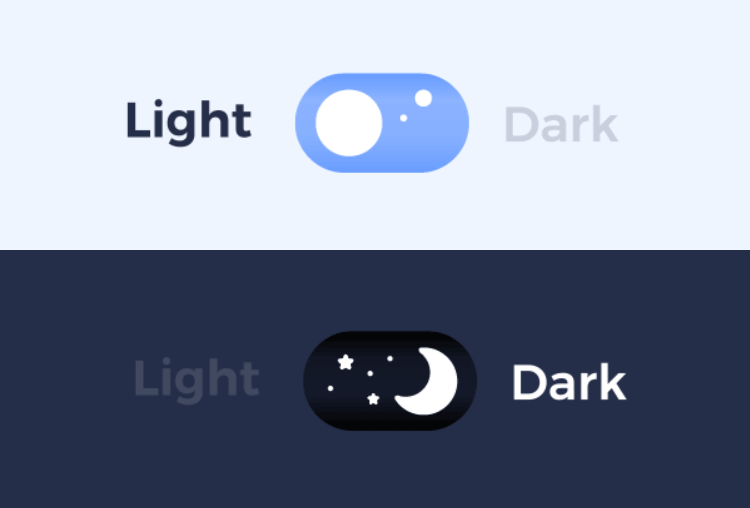
The intermediate values are automatically generated by the editor. Select the Bg + Contrast scale, and pick a dark color for the -color-bg, and a light color for the -color-contrast-higher. Click on the '+' icon next to the 'Themes' label and rename the new theme 'dark'. open console and execute: tItem ('data-theme', 'dark') then refresh the page and execute: localStorage.getItem ('data-theme') if it returns null then there may be something blocking your cookies.

#Dark mode switch codepen code#
What's great is you can also inspect and debug declared CSS variables in browser dev tools, which appear below the stylesheet rules.ĬSS custom properties are declared by words prefixed with two dashes (-), and accessed using the var() function. Create a dark theme Add a switch to the page To create a dark theme, we can use the Colors Editor. If the above code does not work then try the following steps. For example, you can define CSS variables at the document root, and override them in more specific CSS classes. And if you plan on implementing it in your site, youll probably use some kind of toggle switch by Saba. You can define CSS custom properties anywhere in your CSS files, and they follow the same cascading and specificity patterns as other CSS rules. Here's how it's done.ĬSS custom properties are also referred to as CSS variables or cascading variables. Instead, it detects the user's system settings with a CSS media query, and uses two custom CSS properties to determine a basic colour scheme. This solution uses no JavaScript, so we're not building a light and dark mode toggle. But I also know lots of people who prefer light mode! To respect personal preferences and consider accessibility from the start, I add support for native light and dark mode as soon as I begin a new web project. Then, inside the useEffect hook, where we check our localTheme, we’ll add an else statement, and if there is no theme in localStorage, we’ll add it.I like to dark mode all the things. We will create another state and call it componentMounted. However, I am not sure if it’s a good practice to do checks like that inside useState, so let me show you a second solution, that I’m using. The first is to check if there is a value in localStorage in our useState: // useDarkMode.jsĬonst = useState(('theme') || 'light') After that, useEffect runs, checks localStorage and only then sets the theme to dark. That happens because our useState hook initiates the light theme initially. Note: Its use Localstore DarkModeToggel. Do you see that the sun icon loads before the moon icon for a brief moment? The below code creates a dark mode toggle switch btn. Switch to dark theme and reload the page.

This almost works almost perfectly, but there is one small thing we can do to make our experience better.
Sun icon made by smalllikeart from Moon icon made by Freepik fromLight & dark mode, with user-switch button
Inherits dark mode from the OS when enabled, and allows switching in-browser.Here’s what I did: import React from 'react' We’re going to delete everything in there and add the layout for our app. In this tutorial, we’re going to build a toggle that allows users to switch between light and dark modes, using a theme.body} įont-family: BlinkMacSystemFont, -apple-system, 'Segoe UI', Roboto, Helvetica, Arial, sans-serif See the Pen Pure CSS dark mode toggle switcher by Demilade Olaleye ( demilad ) on CodePen. Many websites, including YouTube and Twitter, have implemented it already, and we’re starting to see it trickle onto many other sites as well. Pure CSS dark mode toggle switcher You can see the results below. Dark mode makes web pages easier for me to read and helps my eyes feel more relaxed. Here we are going to provide the user with a simple switch to toggle between dark mode and light mode and we will also try to remember their preference for future visits. I like when websites have a dark mode option.


 0 kommentar(er)
0 kommentar(er)
